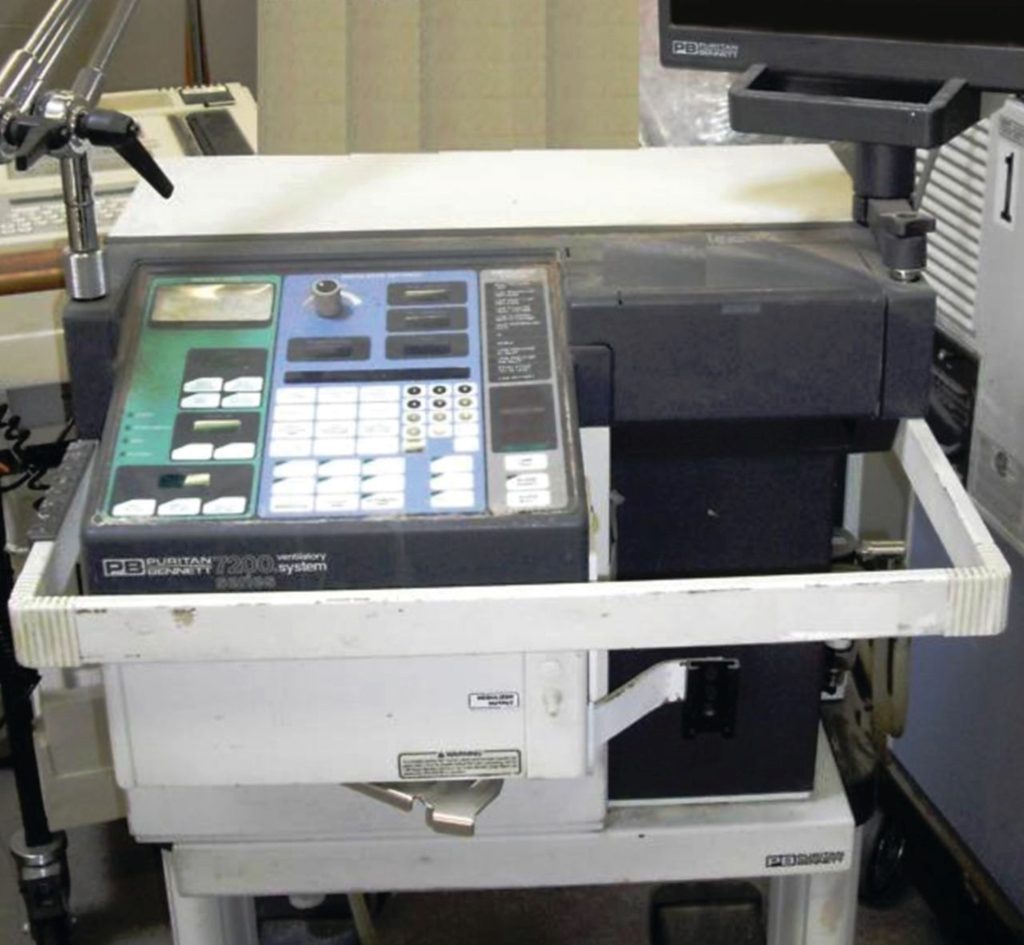2.3 A Brief History of Control and Spontaneous Modes
Based on the type of breath delivered, basic modes of ventilation can be mostly categorized as follows:
- Control mode
- Spontaneous modes
Control modes exist to replace the whole process of breathing. When on a control mode, the ventilator completely controls all phases of a breath including:
- Initiation: Breathing is no longer controlled by the chemoreceptors and diaphragm. The ventilator will push breaths into the lungs at the interval set by the clinician.
- Inhalation: The amount of air pushed into the lungs is determined by what is set. The lungs will inflate because it is a sealed system.
- Termination of inhalation: Once the set amount of air is pushed in, the ventilator will stop pushing air into the lungs.
- Exhalation: The lungs will passively deflate as air moves from high pressure to low pressure.
The control mode is utilized for patients who are not able to breathe on their own or who are not breathing or compensating enough to support the body’s needs. Every single step in the breathing process is determined by what is set by the health care professional. Virtually nothing to do with the respiratory process is decided by the patient.
Key Takeaway
Spontaneous modes are exactly what the name suggests. They allow the patient to be much more involved in the breathing “decision-making process.” The patient can control much more of the pattern and size (or volume) of their breaths, and they can cycle through the phases of a breath based on what they want to do. Spontaneous modes are used in situations where patients have an intact drive to breathe—meaning they are still initiating breaths regularly and the physiological “trigger” in the brain is still functioning to initiate a breath (remember the chemoreceptors?). In spontaneous modes, the patient does have more control over their breathing pattern, but some aspects of the breath are still dependent on what is set on the ventilator and not fully patient-driven.
Object Lesson

A good analogy to understand the difference between control and spontaneous modes is driving to a destination. A control mode is like getting a ride to a destination in a taxi. You are the passenger. The taxi driver determines the speed the car is going as well as the route they take when driving.
On the other hand, a spontaneous mode is similar to driving an automatic car. The person driving has control over the route they are taking and the speed, but the engine is doing some of the “decisions” of driving—like what gear you are in and shifting gears for you. This is similar to a spontaneous mode. Though respiration is mostly patient-driven and in the patient’s control, there are still some small parameters that are set on the ventilator to assist or supplement the process.
Begin your exploration of the history of modes with a refresher on the emergence of ventilation and some key innovations that we have already touched on in Chapter 2. Watch “How do Ventilators Work?” by TED-Ed, and then we will focus on ventilator modes:
The first version of the modern ventilation modes was a mode known as Continuous Mandatory Ventilation (CMV). It was created to artificially breathe for the patient with positive pressure, but only within the parameters set on the ventilator. The ventilator would not sense what the patient was doing or “asking for”. Meaning, if the patient started to trigger breaths and wanted to breathe at a faster respiratory rate than what was set, the ventilator would not deliver it. It was completely blind to the patient.
The problems with this approach are obvious. Imagine being hooked up to a machine and waking up and not being able to breathe when you want to—you try to breathe, but there is no air at all. Not only that, but air is pushed into you when you don’t want it! The CMV mode caused a lot of patient discomfort because the ventilator and the patient were not in sync. This problem is termed asynchrony. To reduce asynchrony, patients had to be highly sedated—and, in a lot of cases, paralyzed. Increased levels of sedation and paralysis made assessing patient’s drive to breathe on their own much more difficult—which posed a challenge when deciding when to discontinue ventilation.
As technology and ventilators advanced, the problems with CMV were quickly identified and ventilators were improved to become much more sensitive to patient efforts. Microprocessors are now able to sense small changes in airflow that represent a patient-triggered breath. Since an effort can now be sensed, the ventilator can deliver a breath on a set “minimum” rate. Or, when the patient causes flow differential that the computer recognizes as an “ask,” the ventilator can go above that minimum rate and deliver a breath. To differentiate this mode from the old CMV, this new mode is often termed “ASSIST/CONTROL” or A/C Ventilation since it has the ability to give breaths as set and additionally when asked for.

Old control modes (CMV) that do not allow patient triggered breaths are completely archaic and do not exist in modern ventilation. A/C has completely replaced CMV as the only type of control mode. Even modes that still remain labelled as CMV on specific ventilators are not the historical version—they also allow patients to breathe above the set rate.
In the past, as patients improved, the set rate would be turned down to allow the patients to initiate all of their breathing. This did not solve all the asynchrony issues. Small variations or pauses in the physiologic breathing pattern of the patient would result in control breaths being delivered, which would stimulate the patient to breathe while the control breath was being delivered—this is referred to as double-triggering. Other asynchronies also resulted from patients wanting to breathe at different flowrates or lengths of time. These issues identified a need for a mode where the patient could fully control their own breathing pattern and length of breath, which brought spontaneous modes to the market.
Spontaneous modes were created for patients that were able to consistently trigger their own breaths with an effective drive to breathe. Spontaneous modes improved asynchrony by allowing patients to control their own air flowrates and cycling of the ventilator through the different phases of breathing. These significant changes represented some of the most significant and historic changes in modern mechanical ventilation, moving towards a focus on mimicking physiologic breathing and normal physiologic breathing patterns.
In contrast to control modes, spontaneous modes widely remain very similar to their original versions. Though there have been some new modes that offer some additional changes to spontaneous ventilation, they are not widely used and will not be covered in the scope of this book.
“Modes of Ventilation: The Basics” and “A Brief History of Control and Spontaneous Modes” from Basic Principles of Mechanical Ventilation by Melody Bishop, © Sault College is licensed under a Creative Commons Attribution-NonCommercial-ShareAlike 4.0 International License, except where otherwise noted.

